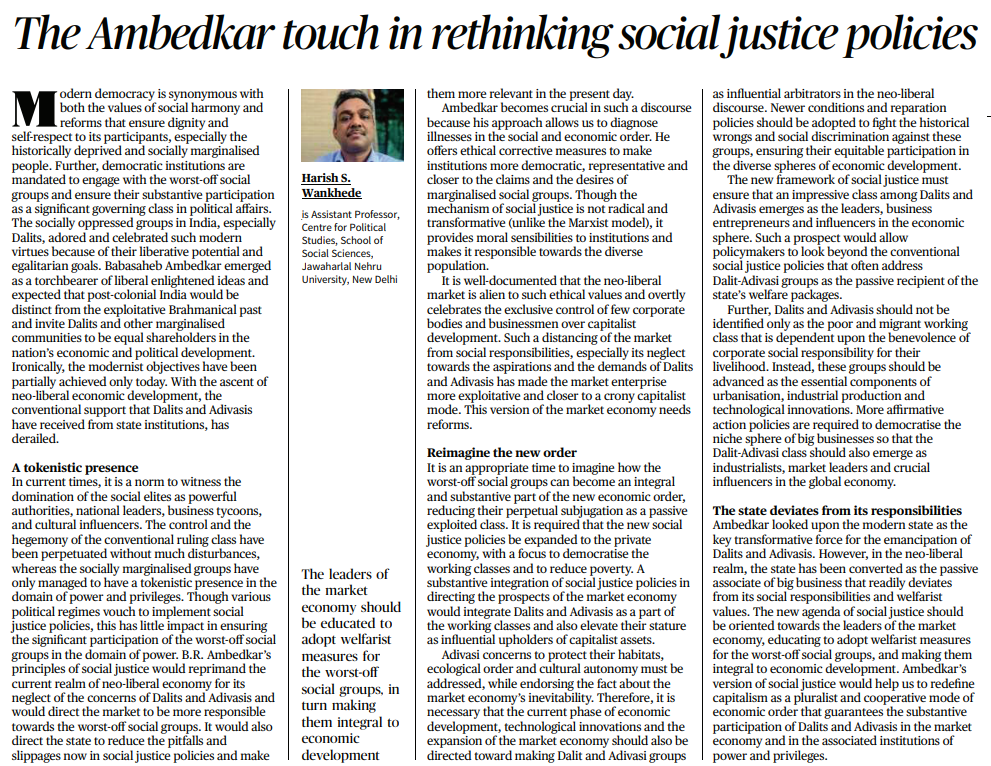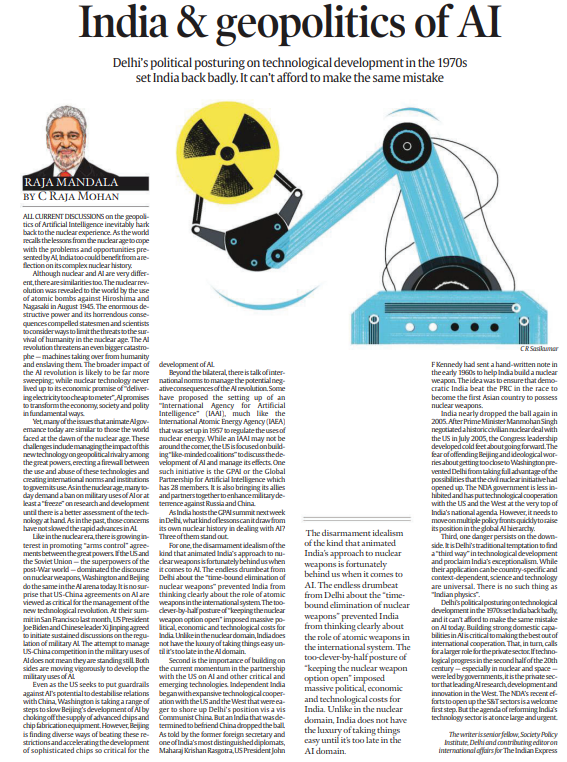Context:
The article elucidates the disparity between Babasaheb Ambedkar’s vision for an inclusive post-colonial India and the current decline in state support for Dalits and Adivasis under the influence of neo-liberalism. It advocates for a revamped social justice framework rooted in Ambedkar’s principles, with a focus on inclusive integration of marginalized groups into the economic structure.
Key Points:
- Democratic Ideals: Modern democracy aims for social harmony and reforms, particularly benefiting historically marginalized groups such as Dalits and Adivasis.
- Ambedkar’s Vision: Babasaheb Ambedkar envisioned a distinct post-colonial India, ensuring equal opportunities for all communities in economic and political development.
- Neo-liberal Impact: The economic development under neo-liberalism has disrupted the traditional support for Dalits and Adivasis from state institutions.
Key Challenges:
- Elite Domination: Various sectors experience the dominance of social elites, perpetuating the control of the traditional ruling class.
- Tokenistic Representation: Socially marginalized groups face tokenistic representation in positions of power and privileges.
- Neglect in Neo-liberalism: The concerns of Dalits and Adivasis are marginalized in the neo-liberal economic model.
Key Terms and Phrases:
- Neo-liberal Economic Development
- Social Justice Policies
- Tokenistic Presence
- Exploitative Brahmanical Past
- Market Economy
- Crony Capitalist Mode
- Economic Order
- Pluralist and Cooperative Mode
Key Quotes:
- “With the rise of neo-liberal economic development, the traditional support for Dalits and Adivasis from state institutions has derailed.”
- “Now is the opportune moment to envision the integration of the worst-off social groups into the new economic order.”
Key Statements:
- Neo-liberal Market Critique: The neo-liberal market lacks ethical values, celebrating the exclusive control of a few corporate bodies and businessmen.
- State’s Role: In the neo-liberal realm, the state has become a passive associate of big business, deviating from its social responsibilities.
Key Examples and References:
- Ambedkar’s Principles: Reference to Babasaheb Ambedkar’s principles of social justice.
- Neo-liberal Impact: Mention of the neglect of Dalit and Adivasi concerns in the neo-liberal economic model.
Key Facts and Data:
- Impact on Support: Decline in traditional support for Dalits and Adivasis with the rise of neo-liberal economic development.
- Tokenistic Representation: Socially marginalized groups experience tokenistic representation in positions of power.
Critical Analysis:
- Neo-liberal Evaluation: Evaluating the impact of the neo-liberal economic model on social justice policies and the neglect of marginalized groups.
- Ambedkar’s Vision: Assessing Ambedkar’s vision as a corrective measure for making institutions more democratic and representative.
Way Forward:
- Policy Expansion: Expand social justice policies to the private economy to democratize working classes and reduce poverty.
- Inclusive Integration: Integrate Dalits and Adivasis as influential contributors to the market economy.
- Affirmative Action: Adopt affirmative action policies to empower Dalit and Adivasi groups as industrialists, market leaders, and influencers.
4. Redefining Capitalism: Redefine capitalism as a pluralist and cooperative mode, ensuring substantive participation of marginalized groups.
Geopolitics of Artificial Intelligence and the Nuclear Parallel
Introduction:
The ongoing discourse on the geopolitics of Artificial Intelligence (AI) draws parallels with the historical context of nuclear developments.
A reflection on India’s intricate nuclear history offers insights into potential strategies for managing the challenges and opportunities presented by the AI revolution.
- Comparing Nuclear and AI Dynamics:
- While nuclear and AI technologies differ significantly, both revolutions have profound global implications.
- The nuclear era, marked by the devastating bombings of Hiroshima and Nagasaki, prompted a collective effort to mitigate threats to humanity.
- Similarly, AI’s potential catastrophe lies in machines superseding human control.
- Unlike nuclear technology, AI’s transformative impact extends beyond expectations, affecting the economy, society, and politics.
- Contemporary Challenges in AI Governance:
- Current challenges in AI governance echo those faced during the nuclear age. Issues include managing geopolitical rivalries among major powers, establishing safeguards against misuse, and creating international norms for responsible AI use.
- Calls for bans on military AI applications or research freezes mirror historical concerns, yet rapid AI advances persist.
- The US-China dynamic, reminiscent of the Cold War, emphasizes the need for arms control agreements to regulate AI development.
- US-China Dominance and Global Initiatives:
- The geopolitical landscape of AI is dominated by the US and China, mirroring the nuclear dynamics of the post-War era.
- While the US seeks to regulate military AI through discussions with China, efforts to impede Chinese AI development are met with resilient strategies.
- The proposal for international norms and institutions, akin to the International Atomic Energy Agency (IAEA), highlights the quest for responsible AI governance.
- Initiatives like the Global Partnership for Artificial Intelligence (GPAI) signify collaborative efforts to address global AI challenges.
- Lessons for India from Nuclear History:
- As India hosts the GPAI summit, lessons from its nuclear history can inform its approach to AI:
- Disarmament Idealism: India’s past nuclear disarmament idealism hindered strategic clarity. Unlike nuclear weapons, India cannot afford complacency in the rapidly evolving AI domain.
- US-India Partnership: The importance of building on momentum in the US-India partnership on critical technologies is emphasized.
Historical instances of missed opportunities, such as the nuclear initiative in the 1960s and the civilian nuclear deal in 2005, underscore the significance of proactive collaboration.
- Avoiding Exceptionalism: India’s historical tendency to seek a “third way” in technological development must be tempered.
Acknowledging the universality of science and technology, particularly in AI, is crucial for effective global participation.
Balancing government initiatives with private sector involvement is paramount for success.
Conclusion:
India’s journey in navigating the geopolitics of AI can draw valuable insights from its nuclear history.
Embracing collaborative international efforts, prioritizing strategic partnerships, and avoiding exceptionalism are essential for India to harness the transformative potential of AI while contributing responsibly to the global AI landscape.



